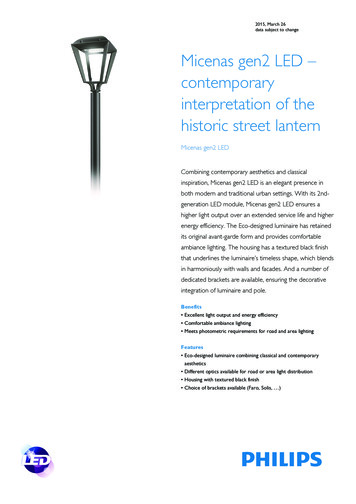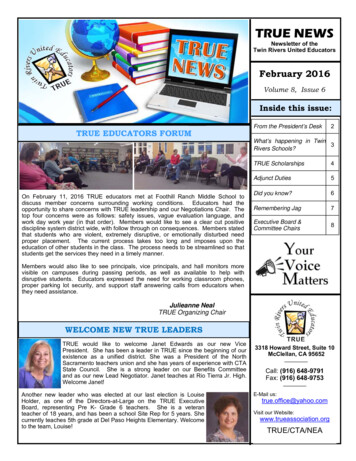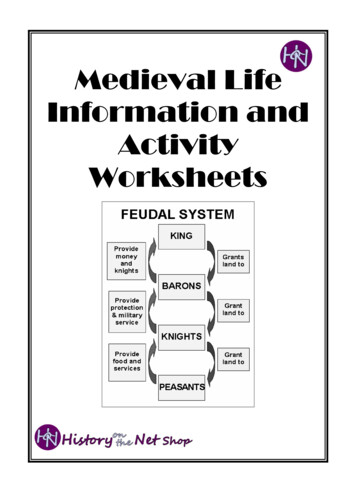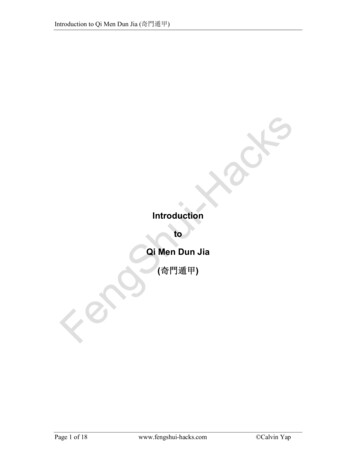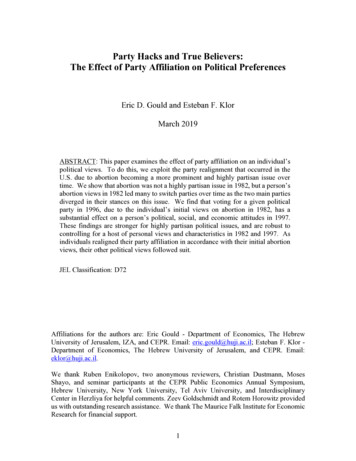
Transcription
Party Hacks and True Believers:The Effect of Party Affiliation on Political PreferencesEric D. Gould and Esteban F. KlorMarch 2019ABSTRACT: This paper examines the effect of party affiliation on an individual’spolitical views. To do this, we exploit the party realignment that occurred in theU.S. due to abortion becoming a more prominent and highly partisan issue overtime. We show that abortion was not a highly partisan issue in 1982, but a person’sabortion views in 1982 led many to switch parties over time as the two main partiesdiverged in their stances on this issue. We find that voting for a given politicalparty in 1996, due to the individual’s initial views on abortion in 1982, has asubstantial effect on a person’s political, social, and economic attitudes in 1997.These findings are stronger for highly partisan political issues, and are robust tocontrolling for a host of personal views and characteristics in 1982 and 1997. Asindividuals realigned their party affiliation in accordance with their initial abortionviews, their other political views followed suit.JEL Classification: D72Affiliations for the authors are: Eric Gould - Department of Economics, The HebrewUniversity of Jerusalem, IZA, and CEPR. Email: eric.gould@huji.ac.il; Esteban F. Klor Department of Economics, The Hebrew University of Jerusalem, and CEPR. Email:eklor@huji.ac.il.We thank Ruben Enikolopov, two anonymous reviewers, Christian Dustmann, MosesShayo, and seminar participants at the CEPR Public Economics Annual Symposium,Hebrew University, New York University, Tel Aviv University, and InterdisciplinaryCenter in Herzliya for helpful comments. Zeev Goldschmidt and Rotem Horowitz providedus with outstanding research assistance. We thank The Maurice Falk Institute for EconomicResearch for financial support.1
1. IntroductionDo individuals support a political party based on their views, or are their viewsshaped by their party identification? This is a central question in studies on the interactionbetween social identity and personal preferences, dating back at least fifty years to theseminal work of Campbell et al. (1960). Several theoretical and experimental studies haveraised the possibility that social context has a crucial impact on an individual’s policypreferences.1 However, there is little systematic empirical research on whether there is aneffect of party identification on an individual’s opinions. The lack of research is likely dueto the difficulty in establishing a causal connection between the two. Both are jointlydetermined, and therefore, a correlation between views and party affiliation reveals littleabout the causal relationship in any particular direction.The idea that political affiliation affects a person’s views is somewhat counterintuitive. It is natural to think that individuals choose which party to support based on theirviews, which results in a strong correlation between a person’s opinions and partyaffiliation. While this is likely to be true, a substantial part of this correlation could be theresult of the party’s influence on the views of those who joined that party for various otherreasons. For example, a person may have strong opinions about economic policies, andchoose a party based primarily on which party is closest to those positions. In the process,the party may influence the person’s stance on a vast array of other issues like foreign policy,criminal sentencing, judicial activism, school choice, affirmative action, school prayer, gaymarriage, etc. Political parties represent a bundle of views over all issues, and it would beimpossible for individuals with randomly determined views across all issues to pick a party,1See Green et al. (2002) and the references cited therein.2
particularly in a two-party system, with similar views on each issue. Yet, supporters of aparty often share a similar outlook over a vast array of disparate issues, and this patternsuggests that causality between party and personal views could be running in bothdirections.This paper focuses on the least understood of these pathways: the extent to whichparty affiliation affects political opinions. In order to identify a causal relationship,exogenous variation on party preferences is required.Although a few studies haveattempted to do this, their identification strategies rely on treating lagged party affiliation asexogenous [Bartels (2002), Carsey and Layman (2006)]. In contrast, we introduce a newstrategy which is based on an individual’s attitude towards legalized abortion, a salient issuethat is generally related to one’s views about when life begins versus the rights of femalesover their reproductive choices. A priori, it seems unlikely that a person’s views on suchmatters should be correlated with his/her preferences on economic issues and other policydimensions. In fact, this appears to be the case during the 1970s in the United States whenthe abortion issue came to the forefront of public debate. As Adams (1997) and Carminesand Woods (2002) show, the two major political parties did not stake out clear stances onabortion as of the late 1970s.Starting in the mid-1980s, however, abortion became an increasingly partisan issue– which is in line with the idea that political parties manipulate religious issues in order torally supporters and increase donations (Glaeser, Ponzetto and Shapiro, 2005). As theparties diverged in their stances on legalized abortion, many individuals found themselvessupporting the “wrong” party in terms of their attitudes on abortion – an issue that is oftendeep-seated in a person’s core values. Therefore, as abortion became increasingly a partisanissue, many individuals with strong beliefs on abortion in either direction were essentially3
forced to change their political affiliation in the mid-1980s and early 1990s accordingly.2Using detailed panel data containing the political views of each respondent in 1982and 1997 on a variety of issues, we show that the abortion stance of an individual in 1982did cause party switching between 1980 and 1996. Holding a pro-life view in 1982 doubledthe probability (12 percent to 24 percent) that a Democratic voter in 1980 switched his/hersupport to the Republicans in 1996. Holding a pro-life view in 1982 increased the chancesthat a Republican voter in 1980 stayed Republican in 1996 by 22 percentage points. To seeif the new party affiliation affected the person’s views on issues other than abortion, let usconsider the example of a person’s opinion about marijuana legalization. Our basic strategyis to control for an individual’s personal characteristics, including their view aboutmarijuana legalization in 1982, and test whether the individual’s political affiliation in 1996(as explained by his or her initial attitudes on abortion in 1982) affects their view aboutmarijuana legalization in 1997. We perform a similar analysis for a host of other political,social, and economic issues.The results show that individuals not only changed their party as of 1997 inaccordance to their abortion views in 1982, but this party realignment led individuals toshift their preferences over other policy dimensions accordingly. That is, as people switchedparties due to their initially held abortion views, their other political views tended to followsuit. These findings hold for a variety of political, economic, and social issues that are notdirectly related to abortion, but are stronger for issues that are more partisan in nature.2The reasons that led the parties to adopt the positions on abortion that they adopted, and to diverge over time,are beyond the scope of our study. See Brady and Schwartz (1995) and Carmines and Woods (2002) forstudies highlighting the role that party activists and party elites played on the evolution of abortion as a partisanissue.4
Our empirical strategy relies on the assumption that individuals were more likely tochange their party identification than their abortion views. This assumption is consistentwith a large body of evidence showing that an individual’s abortion views tend to beconstant over time [Converse and Markus (1979), Tatalovitch and Schier (1993), Wilcoxand Riches (2002), Jelen and Wilkox (2003), and Carsey and Layman (2006)]. The highcorrelation of abortion views over time is present in our data – 76 percent of the individualsin our sample hold the same abortion view between 1982 and 1997, while only 53 percentvoted for the same party. The strength of this correlation is probably due to the idea thatabortion views tend to be based on deeply held religious beliefs. In addition, this issue isframed as a clash of two opposite absolutes, making it difficult for individuals to changetheir minds (Maxwell, 2002).Therefore, the sudden divergence in party platformsregarding abortion offers a unique opportunity to see whether this process inducedindividuals to switch parties, and whether that switch caused individuals to realign theirviews on other issues according to the new party line.Our study is closely related to the rapidly growing theoretical literature on therelationship between a person’s social identity and his/her personal preferences [see, amongmany others, Akerlof and Kranton (2000), Beck et al. (2002), and Shayo (2009)]. Thisliterature is based on the insights of Tajfel and Turner (1979, 1986) regarding social identity.They show that an individual’s political preferences are not only affected by their own selfinterest, but also by their social context and the social groups they choose to identify with.These theoretical advances had been accompanied mostly by experimental evidenceshowing that social identity affects an individual’s preferences over redistribution [Luttmer(2001) and Klor and Shayo (2010)] and level of altruism [Fowler and Kam (2007) and Fongand Luttmer (2009)].5
Achen and Bartels (2016) study the effects of social identity on political outcomes.They call this line of research by the name of group theory of politics, and argue that itpresents “a more scientifically accurate and politically realistic foundation for democratictheory” (Achen and Bartels, 2016, pp. 214). This theory is based on individuals’ tendencyto form groups, which leads to the creation of “us” and “them” and to intergroup conflict.As a consequence, they argue that emotion (rather than reason) has a great impact on groupactivity. At the same time, groups have a great influence on individuals’ preferences andthinking, to the extent that group norms tend to override an individual’s own judgement.Achen and Bartels (2016) provide a number of examples highlighting the effect ofsocial identity in shaping political attitudes. To do this, they focus on historical cases ofpolitical realignments of different groups, and argue that social identities are behind theprocess of partisan realignment at least as much as differences in party platforms. Theyshow, for example, that (i) ethnicity played a substantial role in shaping the politicalbehavior of Jews, Italian Americans, African Americans, Yankees and Irish-Americansduring the New Deal era; (ii) religious identity substantially affected the 1960 US elections,with Catholics showing an unusual and overwhelming support for Kennedy; and (iii) viewson race played a crucial role on the realignment of white southerners in the second half ofthe 20th century.More closely related to our study, Achen and Bartels (2016) show that views onabortion caused the realignment of moral conservatives and liberals in the 1980s and 1990s.Focusing on the same data set used in this study, Achen and Bartels (2016) show thatindividuals are more likely to leave the Republican party between 1982 and 1997 if theyheld liberal views on abortion in 1982. Importantly, their analysis does not control for othercovariates (besides abortion’s views) that may affect this correlation.6
Our study contributes to this literature by examining the way that a person’s politicalparty affiliation, which is often an important component of one’s social identity, influencesa person’s views on a vast array of political, social and economic issues, while usingeconometric tools to establish causality. We show that voting for a party induces individualsto adapt their views to the positions of a prototypical member of the group they choose toidentify with.3Our paper is also related to important studies by Mullainathan and Washington(2009) and Gerber et al. (2010), which analyze the possibility that views are affected byincreased political participation.4 Mullainathan and Washington (2009) compare the viewsof individuals who were eligible to vote in a presidential election to those that were just shyof the eligible age. They find that those who were eligible to vote had stronger views thanthose that were ineligible. They interpret this finding as evidence of cognitive dissonance– individuals mentally adjusted their views to coincide with their previous voting behavior.Gerber et al. (2010) find further evidence that partisanship is affected by political activity3In a recent related experimental study, McCauley (2014) shows that priming different identities in Africaleads individuals to alter their preferences over policy. McCauley’s (2014) findings occur in the laboratoryand without any time elapsed between treatment and survey. We observe similar effects in the field. We alsofind that the effects are persistent over time, since the treatment is fifteen years apart from the surveymeasuring outcomes.4Carsey and Layman (2006) empirically address the issue in our study, but use an empirical strategy basedon the timing of party and preference changes. They estimate two structural equations which capture thecausality of party identification on views and vice versa. Their strategy is based on using lagged partisanshipto estimate the effect on current views. A similar strategy is used in Bartels (2002). However, as argued byGerber et al. (2010), existing studies do not have exogenous party identification, and therefore, are likely tosuffer a bias from omitted variables and reverse causality. In contrast, our strategy is based on the idea thatabortion views during the 1970s and 1980s were not correlated with party identification, but are correlatedwith changing parties in the future as abortion became a partisan issue. This exogenous information aboutparty switches enables us to estimate the causal effect of party identification on political views.7
using a field experiment. Before a primary in Connecticut, the researchers sent remindersto independent voters with partisan leanings that they need to register for a party in order toparticipate in that party’s primary election. They found that individuals who received thereminder were more likely to register for a party and identify with that party than a controlgroup of similar individuals who did not receive the reminder. They did not find an effectof increased partisanship on an individual’s policy opinions, probably due to the short timeelapsed between the treatment and the survey.Mullainathan and Washington (2009) and Gerber et al. (2010) demonstrate thatindividuals are more likely to hold stronger and more consistent views over time if theyinvest more effort in their political participation and in acquiring information. WhereasMullainathan and Washington (2009) estimate the persistent effects of electoralparticipation on polarized beliefs, our approach studies the effect that a permanent break onan individual’s partisanship has on his or her views. Our paper focuses on how anindividual’s party identification affects a person’s views. Individuals that switch partiesbecause of their views on one issue do not have to adapt their views on other issues, yet theytend to do so. Cognitive dissonance is one factor that could explain why a person’s viewsare shaped by party affiliation across a wide array of issues. Individuals may derivedisutility from supporting a party that is at odds with their views on various issues, andtherefore, may adapt their stances in order to increase their attachment to the new party. Itis also possible that individuals supporting a new party become more open and exposed topartisan political information and argumentation, which leads them to alter their preexisting views.Hence, a review of the literature shows that there is little evidence on the causaleffect of party affiliation on an individual’s attitudes. Recent evidence does show that8
increased political participation and information strengthens an individual’s identificationwith the political party that he or she supports. We build on these findings by showing howparty affiliation impacts an individual’s preferences over a wide array of political,economic, and social issues.2. DataOur main data source is a panel data set drawn from the Inter-University Consortiumfor Political and Social Research (ICPSR). This data set, called “Youth-Parent SocializationPanel Study, 1965-1997: Four Waves Combined,” is a longitudinal study of a nationalsample from the graduating high school class of 1965. It contains information on theirevolving political, social, and economic preferences for the years 1965, 1973, 1982, and1997.5 All of the individuals in the survey were between 17 and 19 years old in 1965, andtherefore, can be considered part of the same cohort.The surveys conducted by the “Youth-Parent Socialization Panel Study” focus on awide array of substantive issues affecting American society. These include questions oneconomic and political values, trust in government, social welfare, and the desiredrelationship between state and religion, among many others. There are, in addition, severalquestions regarding the political preferences of the respondent and his or her preferredpolicy position regarding the issue of abortion. Our analysis uses the surveys of 1982 and1997, because these are the only waves which contain information about the respondent’sattitude towards abortion.5General information on these surveys, including methodology, the wording of the questions, and summaryresults are available from 04037. See also Jennings etal. (2004).9
There are two main variables of interest, which are computed separately for the twoavailable years. The first variable relates to the respondent’s abortion position. Thequestion about abortion attitudes is worded as follows:There has been some discussion about abortion during recent years. Whichone of the opinions on this page best agrees with your view? You can just tellme the number of the opinion you choose.1. By law, abortion should never be permitted.2. The law should permit abortion only in case of rape, incest, or when thewoman’s life is in danger.3. The law should permit abortion for reasons other than rape, incest, ordanger to the woman’s life, but only after the need for the abortion has beenclearly established.4. By law, a woman should always be able to obtain an abortion as a matterof personal choice.Answers to this question in the 1982 survey were used to categorize an individual’sstance on abortion in the initial period. Out of 923 respondents, the distribution of answerswas: (1) 6.93 percent; (2) 20.69 percent; (3) 25.89 percent; and (4) 46.48 percent. Weclassify an individual as being anti-abortion if he or she chose answers 1, 2, or 3.6 Thisdefinition results in 53.52 percent of the sample characterized as “pro-life” in 1982.7 Adams(1997) reports a remarkably similar percentage of pro-life individuals using a similardefinition and data from the General Social Survey (see Figure A.1 in the Appendix).6Dropping from the analysis individuals who chose option 3 does not affect any of our results.7This paper does not adopt a normative view on the abortion debate. For ease of exposition, we follow theMerriam Webster definition and call individuals that are against legalizing abortion on demand as “pro-life”individuals. Similarly, following the Merriam Webster definition of the term, we define as “pro-choice” thoseindividuals that favor the legalization of abortion with the least amount of restrictions.10
We observe almost the same distribution of attitudes regarding abortion accordingto the 1997 survey. The distribution of responses in 1997 is: (1) 7.91 percent; (2) 22.32percent; (3) 23.73 percent; and (4) 46.05 percent.This results in 53.95 percent ofindividuals being defined as pro-life.8The second variable of interest is whether or not an individual voted for theRepublican Party in the previous presidential elections. This question refers to the electionsof 1980 for the 1982 survey and to the elections of 1996 for the 1997 wave. The actualwording of the question is: “Who did you vote for in the presidential election?”9 In 1980,53.46 percent of the sample voted for the Republican Party, which dropped to 40 percent in1996.10 The correlation of the Republican vote between these two elections equals 0.41.In addition, we examine a wide array of political, social, and economic attitudes thatwere consistently defined in the 1982 and 1997 waves of the survey. As seen in Table 1,these include attitudes on social issues like marijuana, prayer at school, a woman’s role in8Table A.1 in the appendix presents a cross tabulation of individuals’ abortion attitudes for 1982 and 1997.The table corroborates that individuals’ views on abortion remain constant over time for a majority of theindividuals in our sample. Only 10 individuals (1.09 percent of our sample) show a radical change in theirviews over this issue between 1982 and 1997.9Respondents mentioned six different answers in the 1982 survey: Reagan (45.37% of the sample), Carter(29.47%), Anderson (11.6%), Other (1.3%), Would have voted for Reagan (8.08%), Would have voted forCarter (4.17%). We pooled “Reagan” and “Would have voted for Reagan” as Republican supporters.Respondents mentioned four different answers for the elections of 1996: Dole (40.02%), Clinton (52.12%),Perot (6.36%), Other (1.5%). None of our results is affected if: (i) individuals who answered “Other” aredropped from the sample; (ii) individuals who voted for Ross Perot in 1996 are dropped from the sample orconsidered to be supporters of the Republican Party; (iii) we use “support for the Democratic party” as theexplanatory variable instead of supporting the Republican party; or (iv) we focus on the elections of 1992instead of the elections of 1996.10This reflects the fluctuations of the overall US electorate between those two elections. Reagan obtained50.8 percent of the popular vote in 1980 and Bob Dole obtained 40.7 percent of the popular vote in 1996.11
society, and general trust in the government. They also cover attitudes on the role ofgovernment in society -- whether or not the government should racially integrate schools,help minorities, stop crime, pay attention to public opinion, play a leading role in foreignaffairs, and whether or not the government wastes money. Finally, we use attitudes oneconomic issues like whether the government should provide jobs, be responsible for thebenefit of all citizens, and whether the respondent thinks that unions and big business havetoo much influence.Table 1 presents summary statistics for each attitude, where each one is defined asa dummy variable equal to one if the respondent holds the position closer to the view of theRepublican Party. This table shows that the sample population is almost equally partitionedin terms of abortion attitudes and party lines. Moreover, it is almost equally divided interms of their overall political, social, and economic attitudes for both waves of the survey.For example, according to the 1982 survey, around 45 percent of the respondents seethemselves as conservatives, think that marijuana should not be legal, think that womenshould not have an equal role with men, and do not trust the government. These views areconsistent over time.A majority of the respondents seem to have a view more in line with that of theRepublican Party when asked about the government’s role in society and their attitudes oneconomic issues. Over 60 percent of the sample thinks that the government should not beresponsible for racially integrating schools or providing jobs, and that it wastes a lot ofmoney. That said, some of these attitudes show a great deal of variation over time. Whereasalmost 62 percent of the individuals thought that the government is not responsible forracially integrating schools in 1982, only 43 percent of them held this view in 1997.12
Similarly, we see a substantial drop of over 27 percentage points between 1982 and 1997 inthe share of individuals who think that unions have too much influence.The table also depicts a strong persistence of individual attitudes on abortion overtime. This is reflected in a correlation of 0.593 on abortion views over time at the individuallevel. This is the highest correlation for any of the available attitudes, seconded by whetherpublic schools should be allowed to start each day with prayer, which has a correlation of0.546.The high persistence of abortion views, which is at the heart of our identificationstrategy, corroborates similar results by Converse and Markus (1979) based on a CPS panelstudy in the 1970s. They showed that views on abortion and the legality of marijuana arethe most persistent issues. The remarkable stability of abortion attitudes is also supportedby numerous studies using different methodologies and data sets [see, among many others,Tatalovitch and Schier (1993), Wilcox and Riches (2002), Jelen and Wilcox (2003) andCarsey and Layman (2006)]. Wetstein (1993, 1996) and Wilcox and Riches (2002) arguethat views on abortion are stable because this issue has been controversial since 1973, andit has been framed as a clash of absolutes between the privacy rights of a pregnant womanto choose whether or not to have an abortion versus the right of the fetus to life. Therefore,not only do most individuals have strong beliefs on this issue, but they also find it difficultto change their attitudes on the legality of abortion due to the inexistence of a middle groundin the surrounding public discourse (Maxwell, 2002).Table 2 presents summary statistics by survey year and party support, which we useto measure the degree of partisanship for every attitude. The table compares the proportionof individuals holding a particular attitude that voted for the Republican Party in theprevious presidential elections to the proportion of individuals who hold the same attitude13
but didn’t vote for the Republican Party in the previous elections. We define the differencein proportions between the two groups as the attitude’s degree of partisanship.Table 2 shows that there are stark differences in political views between supportersof each party in the survey of 1982. Substantial differences across party lines are found forviews on abortion, legality of marijuana, women’s role in society, racial integration ofschools, helping minorities, and the government’s responsibility to provide jobs. Theexceptions to this partisan divide are an overall agreement that the government wastesmoney, that the government pays attention to public opinion, and to a lesser degree, that thegovernment should not play a leading role in the affairs of other countries.The results for the 1997 survey depict a similar picture. If anything, the degree ofpartisanship for most attitudes increased over time. Importantly, a comparison of thesurveys shows that trust in government and views on whether the government is run for thebenefit of all depend on the political affiliation of the president at the time. Republicansvoters trust (distrust) the government and believe that it is (not) run for the benefit of allwhen the president belongs to the Republican (Democratic) Party.In addition to the variables listed in Tables 1 and 2, the survey contains detailedpersonal information on each respondent such as: age, gender, ethnicity, education, state ofresidence, state of birth, and employment status. Table 3 presents summary statistics forthese variables, and shows that our sample is predominantly white and highly educated,with high levels of employment in 1997 (all individuals are between 49 and 51 years old in1997). The geographic distribution in terms of state of birth is highly representative of theoverall US population, as is the observed migration to the Pacific and South Atlanticregions, which is seen by their state of residence in 1997.14
3. Empirical StrategyOur empirical strategy is designed to identify the causal effect of party support onan individual’s political, social, and economic attitudes. The unit of observation is theindividual, and we model her attitude on each issue in 1997 as a function of her personalcharacteristics, state of residence, state of birth, her attitude on the same issue in 1982, andwhether she voted for the Republican Party in 1996. Formally, we estimate the followinglinear model:(Individual Attitude)i,97 α (Individual Attitude)i,82 β (Voted Republican)i,96 Xi,97 F µs εi (1)where (Individual Attitude)i,t is a binary indicator for whether individual i holds the givenattitude (as stated in Table 1) according to the survey taken in year t (where t equals 1982or 1997); (Voted Republican)i,96 is a binary indicator for whether individual i voted for theRepublican Party in the 1996 presidential elections; and Xi,97 is a vector of individual andcity level characteristics. This vector includes the individual’s race, gender, education, andemployment status as reported in 1997. It also includes fixed-effects for the individual’sstate of birth and the size category of the city of residence in 1982.11 µs is a fixed-effect forthe individual’s current state of residency s. The error term is given by εi. Note that since11The survey divides city of residence of respondents into 10 categories. These are: up to 2,500; 2,500 –9,99
Party Hacks and True Believers: . Holding a pro-life view in 1982 doubled the probability (12 percent to 24 percent) that a Democratic voter in 1980 switched his/her . on race played a crucial role on the realignment of white southerners in the second half of the 20th century. More closely related to our study, Achen and Bartels (2016) show .


